管理学第十版C1习题与答案
管理学第十、十一章习题

第十章激励原理一、选择题1.根据马斯洛的需求层次理论,人的行为决定于()A.需求层次 B. 激励程度 C. 精神状态 D. 主导需求2.曹雪芹虽食不果腹,仍然坚持《红楼梦》的创作,是出于其()A 自尊需要B 情感需要C 自我实现的需要D 以上都不是3.当一位30-40岁的科研工作者显示出卓越的技术才能时,作为该科研人员的领导对他的最有效的激励应该是:(注意,并不排斥其他方面的适当奖励):A 高额奖金B 配备最好的研究条件C 提职D精神奖励(如评为劳模) 4.在人的各种需要中,最高层次的需要是:A自我实现需要B安全需要C尊重需要D社会需要5.当人们认为自己的报酬与劳动之比,与他人的报酬与劳动之比是相等的,这时就会有较大的激励作用,这种理论称为:A双因素理论B效用理论C公平理论D强化理论6.按照双因素理论,下述哪一种因素属于激励因素:A薪金B上下级关系C工作内容的吸引力D工作的保障7.从期望理论中,我们得到的最重要的启示是()A目标效价高低是激励是否有效的关键B期望概率的高低是激励是否有效的关键C存在着负效价,应引起领导者注意D 应把目标效价和期望概率进行优化组合8.期望理论属于( )A过程型激励理论B行为改造型激励理论C内容型激励理论D激励理论9.一个尊重需求占主导地位的人,下列那种激励措施最能产生效果( )A提薪B升职C解聘威胁D工作扩大化10.以下那种现象不能在需要层次理论中得到合理的解释( )A一个饥饿的人会冒着生命危险去寻找食物B穷人很少参加排场讲究的社交活动C在陋室中苦攻"哥德巴赫猜想"的陈景润D一个安全需求占主导地位的人,可能因为担心失败而拒绝接受富有挑战性的工作11.中国企业引入奖金机制的目的是发挥奖金的激励作用,但到目前,许多企业的奖金已成为工资的一部分,奖金变成了保健因素,这说明( ):A.双因素理论在中国不怎么适用B.保健和激励因素的具体内容在不同的国家是不一样的C.防止激励因素向保健因素转化是管理者的重要作用D.将奖金设计成为激励因素本身就是错误的二、简答题1.动机、目标、激励和行为之间有怎样的关系?2.需要层次理论的主要观点是什么?根据需求层次理论,归纳总结激励他人的基本方法。
管理学第十版C1习题与答案
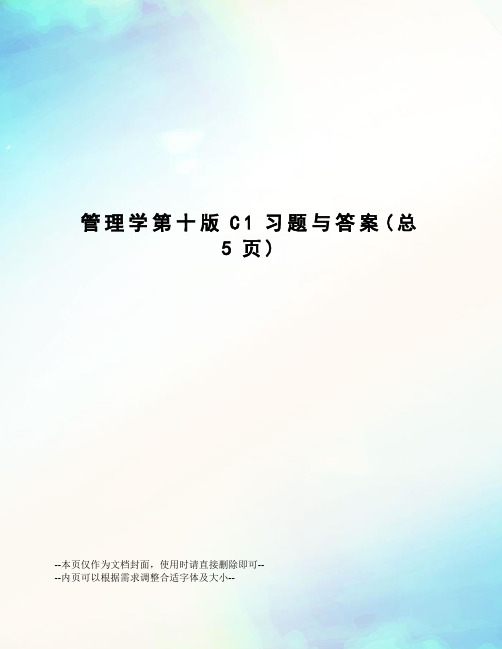
管理学第十版C1习题与答案(总5页)--本页仅作为文档封面,使用时请直接删除即可----内页可以根据需求调整合适字体及大小--1.Management affects employee morale but not a company’s financialperformance.(False)2.In order to be considered a manager, an individual must coordinate the work ofothers.(True)3.Effectiveness refers to the relationship between inputs and outputs. (False)4.Effectiveness is concerned with the means of getting things done, whileefficiency is concerned with the attainment of organizational goals. (False; p. 7)5.Efficiency is often referred to as “doing things right.”(True)6.The four contemporary functions of management are planning, organizing,leading, and controlling.(True)7.The roles of figurehead, leader, and liaison are all interpersonal roles. (True; p. 9)8.Determining who reports to whom is part of the controlling function ofmanagement.(False; Organizing,9.Directing and motivating are part of the controlling function of management. (False;p. 8)10.Katz found that managers needed three essential skills: technical, human,and informational.(False; p. 11)11.Technical skills become less important as a manager moves into higher levelsof management.(True)12.A distinct purpose is important in defining an organization.(True)1.Someone who works with and through other people by coordinating theirwork activities in order to accomplish organizational goals is ___________.a.an assembly line workerb. a laborerc. a managerd. a salesperson(c)2.Which of the following types of managers is responsible for makingorganization-wide decisions and establishing the plans and goals that affect the entire organizationa.first-line managersb.top managersc.production managersd.research managers(b)3.The lowest level of management is ______________.a. a non-managerial employeeb. a department of research managerc. a vice presidentd. a first-line manager(d)4.The distinction between a managerial position and a nonmanagerial positionis _______________.a.planning the work of othersb.coordinating the work of othersc.controlling the work of othersanizing the work of others(b, Page 5)5.Wasting resources is considered to be an example of managerial_____________.a.efficiencyb.effectivenessc.inefficiencyd.ineffectiveness(c)6.Efficiency refers to _____________.a.the relationship between inputs and outputsthe additive relationship(加性关系) between costs and benefitsb.the exponential(指数关系) nature of costs and outputsc.increasing outputs regardless of cost(a; p. 7)7.An automobile manufacturer that increased the total number of carsproduced at the same cost, but with many defects, would be _____________.a.efficient and effectiveb.increasing efficiencyc.increasing effectivenessd.concerned with inputs(b; difficult)8.Today, the basic management functions are considered to be ______________.a.planning, coordinating, staffing, and directingb.planning, organizing, leading, and directingmanding, organizing, leading, and staffingd.planning, organizing, leading, and controlling(d)9.Which of the following management functions from the mid-1950s is nolonger included in the basic functions of management?mandingb.staffingc.leadingd.controlling(b; p. 8)10.A manager resolving conflict among organizational members is performingwhat function?a.controllingmandingc.directingd.leading(d; moderate; p. 8)11.The process of monitoring, comparing, and correcting is called _____________.a.controllingb.coordinatingc.leadinganizing(a)12.According to Mintzberg’s management roles, the _____________ roles arethose that involve people and other duties that are ceremonial and symbolic in nature.rmationalb.interpersonalc.technicald.decisional(b; p. 9)13.A human resource manager attending a local Society for Human ResourceManagement meeting would be functioning in which role?rmationalb.leaderc.liaisond.disseminator(c; moderate; p. 9)14.A finance manager who reads the Wall Street Journal on a regular basiswould be performing which role?15.16.a.figureheadb.monitorc.disseminatord.interpersonal(b)17.The ability to work well with other people, both individually and in a group,requires ________________.a.technical skillsb.assessment skillsc.planning skillsd.human skills(d)18.One of the common characteristics of all organizations is _____________, whichcla rifies members’ work relationships.a.its peopleb.its goalsc.its deliberate structured.its purpose(c)19.A deliberate arrangement of people to accomplish some specific purpose is_____________.a. a structure.b. a process.c.an organization.d.an assembly operation(c)20.Universality of management means that _____________a.all managers in all organizations perform the four management functionsb.all managers in all organizations can perform their job the same wayc.all organizations can hire any manager to perform the management jobsd.any manager can work in any organization and perform anymanagement job(a,P15)21.A primary responsibility of managers is creating a work environment that_______________.a.is safe and well litb.is clean and organizedc.allows employees to do their work to the best of their abilityd.provides excellent customer service (c)。
管理学练习

B1 社会经济系统
7) 管理科学学派中所运用的科学技术方法, 来源于 ( ) 。 A1 学校 B1 科研部门 C1 军队
8) 对企业现在和未来的整体效益活动实行全局性管理, 就是( ) 的核心。 A1 战略管理 B1 经营管理 C1 企业战略
9) 1990 年,美国麻省理工学院斯隆管理学院的彼得· 圣 吉教授出版了一本享誉世界之作,引起世界管理界的轰 动,这就是( ) 。 A1《企业再造工程》
B1《管理的革命》
C1《第五项修炼———学习型组织的艺术与实务》
10) 企业流程再造的目的是增强企业竞争力,从( ) 上保证企业能以最小的成本、高质量的产品和优质的 服务赢得客户。 A1 作业管理 B1 生产流程 C1 生产管理
练习: 一、选择题 1、传英国有上名叫霍布森的商人,他在卖马的时候一直说,允许 顾客任意挑选马匹,但需要符合一个条件,即只能选择靠近门边 的那一匹。在此例中,顾客拥有的决策权限: A很大,因为他可以任意挑选马匹
1) 这是一个网络系统,由输入、处理、输出和反 馈四个环节构成,它在管理各职能中占有重要地位, 这就是管理的( ) 。 A1 控制职能 B1 决策职能 C1 领导职能
2) 企业要正常运转,必须根据企业经营目标,对各 生产要素进行统筹安排和全面调度,使各要素间能 够均衡配置,各环节相互衔接、相互促进。这里的 统筹安排和全面调度就是管理的( ) 职能。
计算题: 1、一家小型企业在家个地区生产出售电动乌龟玩具,该企 业准备将其当前散布在三个不同地点的装配线集中于一个生 产地。其首要候选地月固定成本为 42000美元,单位变动成本 为3美元/只,一只电动乌龟售价7美元。试计算求出盈亏平衡 点及每月产量分别为 10000件、12000件和15000件的总利润、 固定成本、变动动成本和收益。 2、一家汽车清洗店老板必须决定是购买1台还是2台清洗管 线。一条清洗管线每月固定成本为 6000美元,两条管理线为 10500美元。每台清洗管线每小时能清洗汽车15辆,其可变成 本为每辆3美元,每清洗一辆车收费5.95美元。经理预计平均 需求每小时在14~18辆车之间。你建议是购买1条还是2条管线?
管理学练习题库+参考答案
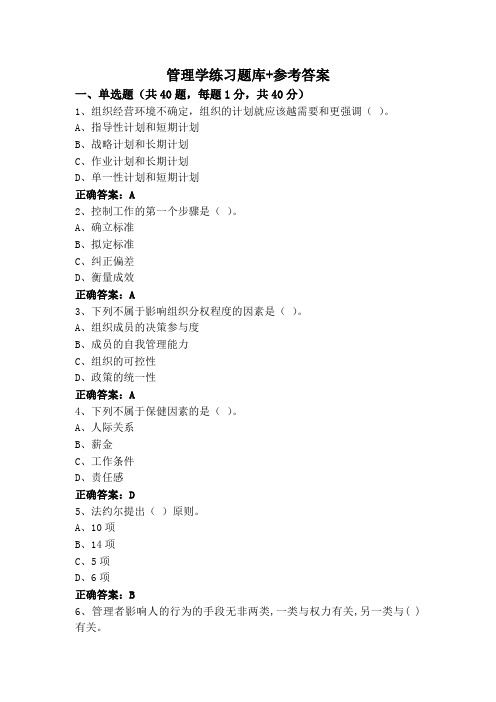
管理学练习题库+参考答案一、单选题(共40题,每题1分,共40分)1、组织经营环境不确定,组织的计划就应该越需要和更强调()。
A、指导性计划和短期计划B、战略计划和长期计划C、作业计划和长期计划D、单一性计划和短期计划正确答案:A2、控制工作的第一个步骤是()。
A、确立标准B、拟定标准C、纠正偏差D、衡量成效正确答案:A3、下列不属于影响组织分权程度的因素是()。
A、组织成员的决策参与度B、成员的自我管理能力C、组织的可控性D、政策的统一性正确答案:A4、下列不属于保健因素的是()。
A、人际关系B、薪金C、工作条件D、责任感正确答案:D5、法约尔提出()原则。
A、10项B、14项C、5项D、6项正确答案:B6、管理者影响人的行为的手段无非两类,一类与权力有关,另一类与( )有关。
A、企业宗旨B、组织文化C、组织目标D、经济效益正确答案:B7、目标管理的基本理论和方法,是由美国管理学者()A、马斯洛B、梅奥C、泰勒D、彼得●德鲁克正确答案:D8、双因素理论中的双因素是指()。
A、人的因素和物的因素B、历史因素与自然因素C、保健因素和激励因素D、经济因素与技术因素正确答案:C9、不确定性决策和风险决策的主要区别在于()A、环境的稳定性B、风险的大小C、可控程度D、能否估计事件的概率正确答案:D10、下列哪位管理学家是经验管理学派的代表人物?()A、孔茨B、西蒙C、赫茨伯格D、德鲁克正确答案:D11、在各种沟通网络中,传递消息速度最快的一种是()。
A、轮式B、全通道式C、Y式D、链式正确答案:D12、控制工作是通过纠正偏差的行动与其他四个职能紧密结合在一起,使管理过程形成了一个()A、相对封闭的系统B、相对开放的系统C、绝对封闭的系统D、绝对开放的系统正确答案:A13、“大河有水小河满”和“小河有水大河干”说明了:()A、系统的整体功能不等于个体功能之和B、系统的结构决定了系统的整体功能C、人们所持的心态不同D、人们看问题的角度不同正确答案:A14、领导权变理论认为,从领导者的角度来说,()是最重要的。
管理学多选练习及答案126道
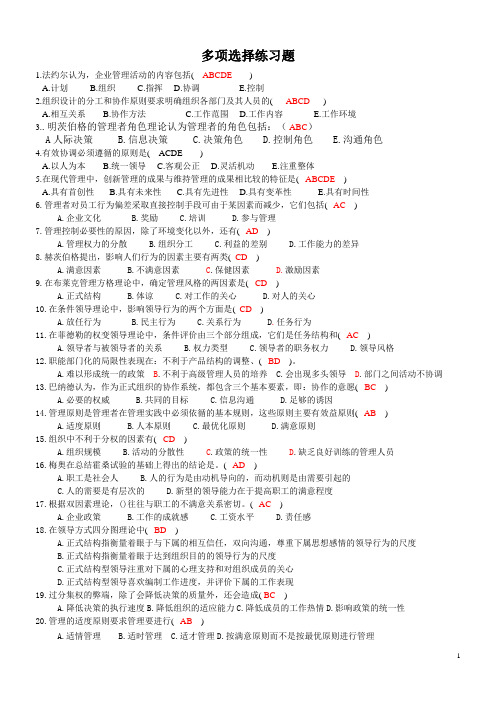
多项选择练习题1.法约尔认为,企业管理活动的内容包括( ABCDE )A.计划B.组织C.指挥D.协调E.控制2.组织设计的分工和协作原则要求明确组织各部门及其人员的( ABCD)A.相互关系B.协作方法C.工作范围D.工作内容E.工作环境3..明茨伯格的管理者角色理论认为管理者的角色包括:(ABC)A人际决策 B.信息决策 C.决策角色 D.控制角色 E.沟通角色4.有效协调必须遵循的原则是( ACDE )A.以人为本B.统一领导C.客观公正D.灵活机动E.注重整体5.在现代管理中,创新管理的成果与维持管理的成果相比较的特征是( ABCDE )A.具有首创性B.具有未来性C.具有先进性D.具有变革性E.具有时间性6.管理者对员工行为偏差采取直接控制手段可由于某因素而减少,它们包括( AC )A.企业文化B.奖励C.培训D.参与管理7.管理控制必要性的原因,除了环境变化以外,还有( AD )A.管理权力的分散B.组织分工C.利益的差别D.工作能力的差异8.赫茨伯格提出,影响人们行为的因素主要有两类( CD )A.满意因素B.不满意因素C.保健因素D.激励因素9.在布莱克管理方格理论中,确定管理风格的两因素是( CD )A.正式结构B.体谅C.对工作的关心D.对人的关心10.在条件领导理论中,影响领导行为的两个方面是( CD )A.放任行为B.民主行为C.关系行为D.任务行为11.在菲德勒的权变领导理论中,条件评价由三个部分组成,它们是任务结构和( AC )A.领导者与被领导者的关系B.权力类型C.领导者的职务权力D.领导风格12.职能部门化的局限性表现在:不利于产品结构的调整、( BD )。
A.难以形成统一的政策B.不利于高级管理人员的培养C.会出现多头领导D.部门之间活动不协调13.巴纳德认为,作为正式组织的协作系统,都包含三个基本要素,即:协作的意愿( BC )A.必要的权威B.共同的目标C.信息沟通D.足够的诱因14.管理原则是管理者在管理实践中必须依循的基本规则,这些原则主要有效益原则( AB )A.适度原则B.人本原则C.最优化原则D.满意原则15.组织中不利于分权的因素有( CD )A.组织规模B.活动的分散性C.政策的统一性D.缺乏良好训练的管理人员16.梅奥在总结霍桑试验的基础上得出的结论是。
《管理学》章节习题含答案
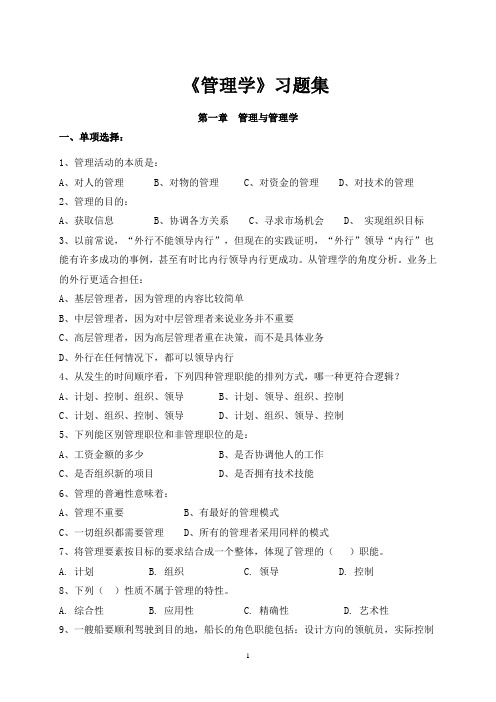
《管理学》习题集第一章管理与管理学一、单项选择:1、管理活动的本质是:A、对人的管理B、对物的管理C、对资金的管理D、对技术的管理2、管理的目的:A、获取信息B、协调各方关系C、寻求市场机会D、实现组织目标3、以前常说,“外行不能领导内行”,但现在的实践证明,“外行”领导“内行”也能有许多成功的事例,甚至有时比内行领导内行更成功。
从管理学的角度分析。
业务上的外行更适合担任:A、基层管理者,因为管理的内容比较简单B、中层管理者,因为对中层管理者来说业务并不重要C、高层管理者,因为高层管理者重在决策,而不是具体业务D、外行在任何情况下,都可以领导内行4、从发生的时间顺序看,下列四种管理职能的排列方式,哪一种更符合逻辑?A、计划、控制、组织、领导B、计划、领导、组织、控制C、计划、组织、控制、领导D、计划、组织、领导、控制5、下列能区别管理职位和非管理职位的是:A、工资金额的多少B、是否协调他人的工作C、是否组织新的项目D、是否拥有技术技能6、管理的普遍性意味着:A、管理不重要B、有最好的管理模式C、一切组织都需要管理D、所有的管理者采用同样的模式7、将管理要素按目标的要求结合成一个整体,体现了管理的()职能。
A. 计划B. 组织C. 领导D. 控制8、下列()性质不属于管理的特性。
A. 综合性B. 应用性C. 精确性D. 艺术性9、一艘船要顺利驾驶到目的地,船长的角色职能包括:设计方向的领航员,实际控制方向和舵手,轮船的设计者或选用者,以及全体船员形成支持、参与和沟通关系的促进者。
这些是组织中的()职能。
A. 计划、控制、组织和领导B. 计划、组织、领导和控制C. 领导、计划、组织和控制D. 领导、组织、计划和控制10、某大企业人才济济、设备精良,长期以来以管理正规有序而自翔。
但近来该企业业绩不佳,尤其是干群士气低落,管理人员和技术人员的流失率逐年升高。
从管理职能分析,该企业最有可能是()工作存在问题。
《管理学》课后习题答案
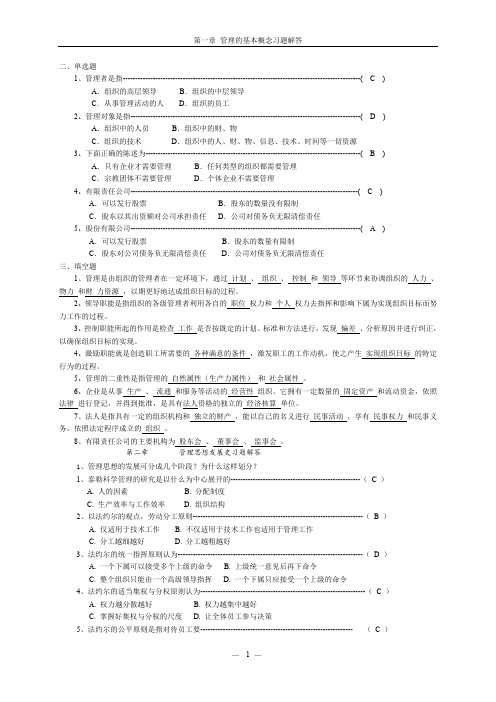
二、单选题1、管理者是指-----------------------------------------------------------------------------------------------( C )A.组织的高层领导B.组织的中层领导C.从事管理活动的人D.组织的员工2、管理对象是指--------------------------------------------------------------------------------------------( D )A.组织中的人员B.组织中的财、物C.组织的技术D.组织中的人、财、物、信息、技术、时间等一切资源3、下面正确的陈述为--------------------------------------------------------------------------------------( B )A.只有企业才需要管理B.任何类型的组织都需要管理C.宗教团体不需要管理D.个体企业不需要管理4、有限责任公司-------------------------------------------------------------------------------------------( C )A.可以发行股票B.股东的数量没有限制C.股东以其出资额对公司承担责任D.公司对债务负无限清偿责任5、股份有限公司--------------------------------------------------------------------------------------------( A )A.可以发行股票B.股东的数量有限制C.股东对公司债务负无限清偿责任D.公司对债务负无限清偿责任三、填空题1、管理是由组织的管理者在一定环境下,通过计划、组织、控制和领导等环节来协调组织的人力、物力和财力资源,以期更好地达成组织目标的过程。
《管理学》习题与答案——第17章 激励

一、教学要点1、解释激励过程。
2、卢因的力场理论的基本内容。
3、马斯洛的需要层次理论的基本内容。
4、需要的性质。
5、弗鲁姆的期望理论的基本内容。
6、亚当斯的公平理论的基本内容。
7、斯金纳的强化理论的基本内容。
8、波特和劳勒的综合激励模型的基本内容。
9、四种激励方法的基本内涵。
10、关键名词:激励、力场理论、需要层次理论、需要、期望理论、公平理论、强化理论、正强化、负强化、二、习题(一)填充题1.管理的激励职能就是研究如何根据规律性来提高人的________________。
2.________________是产生激励的起点,进而导致某种行为。
3. 根据弗鲁姆的期望理论,所谓效价是指个人对达到某种预期效果的__________,或某种预期成果可能给行为者个人带来的___________。
4.根据弗鲁姆的期望理论,激励力=某一行动结果的__________×____________。
5. 库尔特·卢因(Kurt LEwin)把人看作是在一个力场上活动的,力场内并存着________和__________,人的行为便是场内诸力作用的产物。
6.美国心理学家_____________提出了需要层次理论。
7. 马斯洛将需要划分为五级:_________、__________、_________、__________、__________。
8.尊重的需要可以分为两类,即_______________和_____________。
9.安全的需要可以分为两小类,即_______的安全的需要和对_______的安全的需要。
10.需要具有__________,__________,_________,___________的特征。
11.需要的可变性是指需要的____________、从而需要的_________是可以改变的。
12. 期望理论的基础是____________,它认为每一员工都在寻求获得最大的________。
《财务管理学》习题参考答案
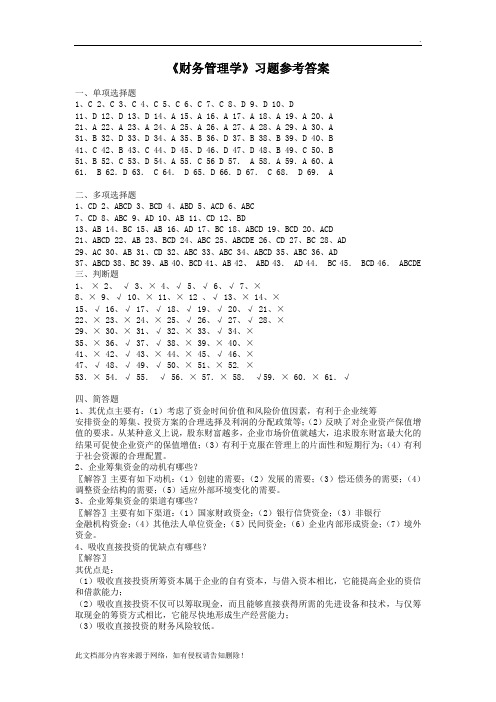
《财务管理学》习题参考答案一、单项选择题1、C2、C3、C4、C5、C6、C7、C8、D9、D 10、D11、D 12、D 13、D 14、A 15、A 16、A 17、A 18、A 19、A 20、A21、A 22、A 23、A 24、A 25、A 26、A 27、A 28、A 29、A 30、A31、B 32、D 33、D 34、A 35、B 36、D 37、B 38、B 39、D 40、B41、C 42、B 43、C 44、D 45、D 46、D 47、D 48、B 49、C 50、B51、B 52、C 53、D 54、A 55.C 56 D 57. A 58.A 59.A 60、A61. B 62.D 63. C 64. D 65.D 66.D 67. C 68. D 69. A二、多项选择题1、CD2、ABCD3、BCD4、ABD5、ACD6、ABC7、CD 8、ABC 9、AD 10、AB 11、CD 12、BD13、AB 14、BC 15、AB 16、AD 17、BC 18、ABCD 19、BCD 20、ACD21、ABCD 22、AB 23、BCD 24、ABC 25、ABCDE 26、CD 27、BC 28、AD29、AC 30、AB 31、CD 32、ABC 33、ABC 34、ABCD 35、ABC 36、AD37、ABCD 38、BC 39、AB 40、BCD 41、AB 42、 ABD 43. AD 44. BC 45. BCD 46. ABCDE三、判断题1、×2、√3、×4、√5、√6、√7、×8、× 9、√ 10、× 11、× 12 、√ 13、× 14、×15、√ 16、√ 17、√ 18、√ 19、√ 20、√ 21、×22、× 23、× 24、× 25、√ 26、√ 27、√ 28、×29、× 30、× 31、√ 32、× 33、√ 34、×35、× 36、√ 37、√ 38、× 39、× 40、×41、× 42、√ 43、× 44、× 45、√ 46、×47、√ 48、√ 49、√ 50、× 51、× 52. ×53.× 54.√ 55.√ 56.× 57.× 58.√59.× 60.× 61.√四、简答题1、其优点主要有:(1)考虑了资金时间价值和风险价值因素,有利于企业统筹安排资金的筹集、投资方案的合理选择及利润的分配政策等;(2)反映了对企业资产保值增值的要求。
2023年军队文职招录《管理学》习题库(含答案)

2023年军队文职招录《管理学》习题库(含答案)学校:________ 班级:________ 姓名:________ 考号:________一、单选题(35题)1.经济学认为,最宝贵的资源,或者说第一资源,应该是:A.物力资源B.财力资源C.人力资源D.信息资源2.人力资源管理,主要用来协调人与事的关系,处理矛盾,发挥人的遭能。
其处理矛盾主要是指()。
A.人与环境B.人与事C.人与人D.人与物3.决策能力是一种综合能力,它由分析问题的能力、逻辑判断的能力、开拓创新能力以及决策者知识经验等特质相关的()组成。
A.观察能力B.协调能力C.直觉能力D.指挥能力4.授权的步骤不包括()。
A.分流职责B.建立责任C.委任职权D. 责任下放5.下列方法中,()方法具有客观化、系统化和规模化的优点。
这种甄选根据组织需要设计标准化问题,对大批量的应试者进行全面测量与评价,信度和效度较高。
A.表格甄选B.简历甄选C.电话甄选D.笔试甄选6.关于薪酬管理的原则,表述正确的是()。
A.公平原则是薪酬管理系统的基础,它强调按劳分配B.薪酬管理应坚持稳定性原则,随意改变薪酬水平会引起不公平C.薪酬管理政策是组织内部的事,不受环境的影响和制约D.组织的薪酬体系应以组织获取最大经济利益为原则7.根据(),行政机关在非常规状态下,即使没有针对某种特殊情况的具体法律规定作为依据,也可以进行紧急处置,以防止公共利益和公民权利受到更大的损失。
A.权力优先权B.程序特殊性C.紧急处置权D.社会配合性8.组织结构是对完成组织目标的人员、工作、技术和信息所作的()。
A.框架性安排B.正规化安排C.制度性安排D.差异化管理9.需要层次理论是美国著名管理心理学家和行为学家马斯洛提出来的一种激励理论,在激励理论类型上它属于:A.行为改造型激励理论B.需要型激励理论C.过程型激励理论D.内容型激励理论10.新公共管理的行政责任观强调(),而传统公共行政的责任观强调()。
管理学第1章 习题

难度:1 参考页码:5 目标内容:1.1 6)效力是指投入和产出之间的关系。 答案:错误 解释:效率强调投入与产出比的最大化。另一方面,效力不关注资源如何被有效利 用,而是关注运用哪些资源,这些资源的运用是否有利于实现组织目标。 难度:2 参考页码:6 目标内容:1.2 7)效率的目标是最大化投入成本时,实现输出成本最小。 答案:错误 解释:效率的目标正好相反,效率的目标是最小化的投入实现最大化的产出。一个 有效率的过程是运用最少的资源生产出数量最多的产品。 难度:2 参考页码:6 目标内容:1. 8)效力是指组织目标的实现。 答案:正确 解释:效力关注的是“做正确的事”——选择有助于组织实现其目标的业务。另一 方面,效率是指“正确地做事”,即用最少的耗费完成已选择的业务。 难度:2 参考页码:6 目标内容:1.2 9)能够有效完成组织目标的管理者往往其行动是有效率的。 答案:错误 解释:一个管理者可能是有效果的,但不一定有效率。例如,一名管理者可能出色 地完成了目标,但是为了实现目标他浪费了很多金钱、精力和资源。 难度:3 参考页码:6 目标内容:1.2 10)当代四个管理过程是计划、组织、领导和指挥。
解释:A)随着时代的发展,传统白种中年男性的管理者形象已经被不同年龄、种族、 性别的人代替。组织管理者工作也千变万化。无论是小公司还是大公司,营利性组织还 是非营利性组织,都有管理者。最后,尽管当今女性管理者比以前要多,但是本文并不 能证实“超过半数以上的管理者是女性”这一陈述。
难度:2 参考页码:4 美国国际商学院联合会(AACSB):理解多文化和多样化 目标内容:1.1 学习目标:讨论管理者不同的工作方式,并促进组织的多样化 32)一个组织是()。 A)人们工作的地点 B)承担相似工作的人们的集合 C)完成某些特定目标内容的人们的刻意安排 D)为股东谋利的群体 答案:C 解释:C)组织是拥有共同目标内容的人们的刻意安排。组织可能存在或也可能不存 在一个独立的办公地点。例如,当今许多政治宣传组织大多都是以虚拟的网络实体形式 存在,并没有基本的办公地点。虽然一个组织中的一些人可能承担相似的工作,但许多人 不是。例如,医生和管理人员都可能在同一家医院工作,但是承担着完全不同的工作。 最后,重视利润并不能确定一个组织。许多组织,如观鸟俱乐部,并不将追求利润作为 目标内容。 难度:2 参考页码:4 目标内容:1.1 33)所有组织都有决定组织的目的和存在原因的()。 A)限制 B)规则 C)结构 D)目标内容 答案:D 解释:D)组织的目标内容,确定了其目标内容和存在的原因。例如,银行的目标内 容可能是赚钱,而一个教堂唱诗班的目标内容可能是创作优美的音乐。规则能够帮助组
管理学 1-9章练习题

第一章管理与管理学一、单项选择题1.管理的“载体”是(B )。
A计划B组织C领导D控制2.管理的核心是(C )。
A财务控制B战略制定C处理人际关系D设计运行组织结构3.“组织共同劳动而产生,反映了社会协作劳动本身的要求,力求用先进的科学方法合理地组织生产力,以保证生产过程的顺利进行。
”这是指管理的(C )。
A科学性B艺术性C自然属性D社会属性4.“由社会生产关系决定,反映一定社会形态中统治阶级的要求,受到生产关系或经济基础的影响和制约,按统治阶级意志调整人们之间的相互关系,维持和完善生产关系。
”这是指管理的(D )。
A科学性B艺术性C自然属性D社会属性5.“没有实践便无所谓管理”是指管理学哪一特征(A )。
A应用性B综合性C复杂性D独立性6.通过对客观存在的一系列典型事物(经验)进行观察,从掌握典型事物的典型特点.典型关系入手,进而分析研究事物之间的因果关系,从中找出事物变化发展的一般规律。
这种方法是管理学研究的哪一种方法。
(B )A比较方法B归纳法C试验模拟方法D可行性试验7.比较管理学最早产生于20世纪50年代末,是伴随(A )的发展于经济国际化的趋势而不断发展起来的。
A跨国公司B股份有限公司C有限责任公司D独资公司8.(B )的主要职责是:制定组织的总体目标.掌握组织的大政方针.评价整个组织的绩效等。
A专业管理人员B高层管理人员C中层管理人员D基层管理人员9.(D )的主要职责是:指挥和从事具体的管理活动。
A专业管理人员B高层管理人员C中层管理人员D基层管理人员10.(B )对于任何层次的管理人员来说,都是同等重要的。
A技术技能B人事技能C决策技能D概念技能11.按照人本原理的观点,现代管理的核心是(B )。
A人是管理的主体B有效管理的关键是员工参与C使人性得到最完美的发展D管理是为人服务的12.在人本原理的动力原则中,(A )是根本。
A物质动力B精神动力C信息动力D外界压力13.在现代管理中,(A )是管理的主体。
《管理学》习题与答案——第02章 管理思想的发展
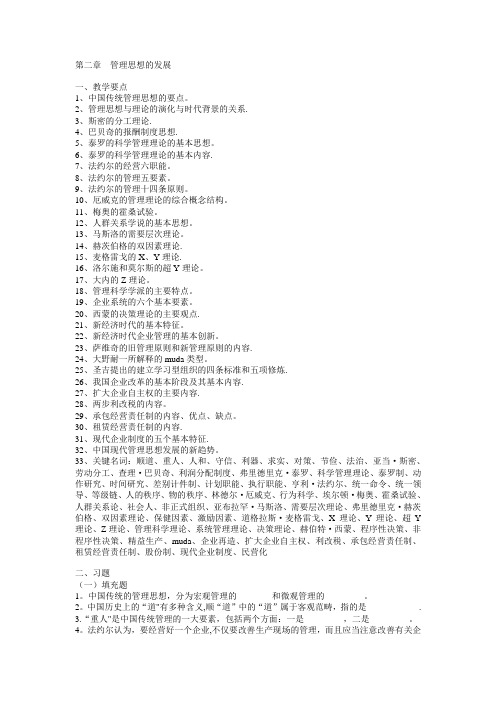
第二章管理思想的发展一、教学要点1、中国传统管理思想的要点。
2、管理思想与理论的演化与时代背景的关系.3、斯密的分工理论.4、巴贝奇的报酬制度思想.5、泰罗的科学管理理论的基本思想。
6、泰罗的科学管理理论的基本内容.7、法约尔的经营六职能。
8、法约尔的管理五要素。
9、法约尔的管理十四条原则。
10、厄威克的管理理论的综合概念结构。
11、梅奥的霍桑试验。
12、人群关系学说的基本思想。
13、马斯洛的需要层次理论。
14、赫茨伯格的双因素理论.15、麦格雷戈的X、Y理论.16、洛尔施和莫尔斯的超Y理论。
17、大内的Z理论。
18、管理科学学派的主要特点。
19、企业系统的六个基本要素。
20、西蒙的决策理论的主要观点.21、新经济时代的基本特征。
22、新经济时代企业管理的基本创新。
23、萨维奇的旧管理原则和新管理原则的内容.24、大野耐一所解释的muda类型。
25、圣吉提出的建立学习型组织的四条标准和五项修炼.26、我国企业改革的基本阶段及其基本内容.27、扩大企业自主权的主要内容.28、两步利改税的内容。
29、承包经营责任制的内容、优点、缺点。
30、租赁经营责任制的内容.31、现代企业制度的五个基本特征.32、中国现代管理思想发展的新趋势。
33、关键名词:顺道、重人、人和、守信、利器、求实、对策、节俭、法治、亚当·斯密、劳动分工、查理·巴贝奇、利润分配制度、弗里德里克·泰罗、科学管理理论、泰罗制、动作研究、时间研究、差别计件制、计划职能、执行职能、亨利·法约尔、统一命令、统一领导、等级链、人的秩序、物的秩序、林德尔·厄威克、行为科学、埃尔顿·梅奥、霍桑试验、人群关系论、社会人、非正式组织、亚布拉罕·马斯洛、需要层次理论、弗里德里克·赫茨伯格、双因素理论、保健因素、激励因素、道格拉斯·麦格雷戈、X理论、Y理论、超Y 理论、Z理论、管理科学理论、系统管理理论、决策理论、赫伯特·西蒙、程序性决策、非程序性决策、精益生产、muda、企业再造、扩大企业自主权、利改税、承包经营责任制、租赁经营责任制、股份制、现代企业制度、民营化二、习题(一)填充题1。
管理学 第一章 管理与管理者 习题答案

第一章管理与管理者TRUE/FALSE1. 管理自从有了人类集体活动以来就开始了。
ANS: T2. 管理就是对一个组织所拥有的物质资源和人力资源进行计划、组织、领导和控制,实现组织目标。
ANS: F3. 管理的基本活动对任何组织都有着普遍性,但盈利性组织比非盈利性组织更需要加强管理。
ANS: F4. 高层管理人员花在计划决策上的时间相对更多一些。
ANS: T5. 中级管理人员往往处理现场、指导操作等技术性工作较多。
ANS: F6. 组织中向外界发布信息的角色称为组织发言人。
ANS: T7. 计划工作之后自然就需要组织工作来发挥作用。
ANS: T8. 管理的有效性在于充分利用各种资源,以最少的消耗有效地实现组织目标。
ANS: T9. 基层第一线管理人员对操作者的活动进行日常监督管理。
ANS: T10. 部门经理属于高层管理人员。
ANS: F11. 管理人员的沟通联络活动属于决策方面角色的职能。
ANS: F12. 技术技能是指沟通、领导、激励下属的能力。
ANS: F13. 技术技能对管理人员非常重要,因为它能使管理人员通过分析确定问题的所在,得出解决的办法。
ANS: F14. 领导工作涉及为各项职务配备合适人选,并通过激励调动组织成员的积极性。
ANS: F15. 为达到共同目标而一起工作的群体是组织。
ANS: T16. 对人力、财力、物力、信息资源进行计划、组织、领导、控制活动的主体为管理人员。
ANS: T17. 负责组织成员的挑选、培训、使用、解雇等工作的管理人员是人事管理人员。
ANS: T18. 对基层第一线管理人员最重要的管理技能是技术技能。
ANS: T19. 制定战略目标是基层管理人员的工作。
ANS: F20. 管理的四项基本活动是计划、人事、经营、控制。
ANS: F21. 管理概念在不同国家间具有可转移性。
ANS: F22. 管理的首要职能是控制。
ANS: F23. 管理者是指挥别人活动的人。
管理学第十版C3练习及答案

1.In the symbolic view of management, managers are seen as directly responsiblefor an organization’s success or failure.(False)2.In the omnipotent view of management, much of an organization’s success orfailure is due to forces outside management’s control.(False)3.An organizational culture refers to a system of shared meaning.(True)anizational cultures influence how employees behave in an organization. (True)5.Strong cultures have more influence on employees than do weak cultures. (True)6.An organization’s founder has little influence on its culture.(False)7.Rituals are repetitive sequences of activities that express and reinforce the keyvalues of an organization.(True)anizational stories typically contain a narrative regarding significant events orpeople.(True)9.To increase customer responsiveness, organizations should hire employees whoare outgoing and friendly.(True)10.To encourage a customer-responsive culture, organizations should formalize andenforce strict customer service policies.(False)11.The general environment refers to environmental factors operating inside anorganization.(False)12.The part of the environment directly related to achievement of an or ganization’sgoals is the specific environment.(True)13.Industry conditions are an example of an organization’s general environment. (False)14.Economic conditions are part of the organization’s specific environment. (False)15.Which of the following represent the two views of managerial impact on thesuccess or failure of the organization?a.omnipotent and symbolicb.omnipotent and reflectivec.symbolic and interactived.reflective and interactive(a)16.The __________ view of management is consistent with the stereotypicalpicture of the take-charge business executive who can overcome anyobstacle in carrying out the organization’s objectives.a.omnipotentb.symbolicc.functionald.systems(a)17.Which of the following most accurately reflects the symbolic view ofmanagement?a.M anagers are directly responsible for an organization’s success or failure.b.M anagers have little or no responsibility for an organization’s success orfailure.c.E xternal forces are directly responsible for an organization’s success orfailure.d.E mployees are directly responsible for an organization’s success or failure.(c)18.Internal constraints that restrict a manager’s decision options _______________.a.exist within every organizationb.do not exist, as all managers have decision-making discretionc.exist only to the extent that upper management imposes themd.exist only to the extent that followers won’t do as they are told(a)19.In reality, managers are most accurately viewed as _________.a.dominant over an organization’s environmentb.neither helpless nor all powerfulc.powerless to influence an organization’s performanced.ultimately responsible for organizational outcomes(b)20.All organizational cultures consist of each of the following except _________.a.shared valuesb.principlesc.innovationd.traditions(c)21.Strong cultures _____________.a.are found in organizations with high employee turnoverb.have a minimal influence on employee decision makingc.can be found in all organizations that existd.have a greater influence on employees than do weak cultures(d)22.Which of the following is not considered to be a dimension of organizationalculture?a.attention to detailb.people orientationc.purchasing policiesd.aggressiveness(c)23.Which of the following dimensions of organizational culture is defined as thedegree to wh ich an organization’s actions and decisions emphasize maintaining the status quo?a.stabilityb.outcome orientationc.team orientationd.innovation and risk taking(a)24.Sony Corporation’s focus on product innovation is an example of which of thefollowing dimensions of organizational culture?a.attention to detailb.people orientationc.outcome orientationd.aggressiveness(c)25.Corporate ___________ are repetitive sequences of activities that expressand reinforce the values of an organization.nguagesb.ritualsc.symbolsd.ceremonies(b)26.Which of the following represents the most significant ways throughwhich corporate cultures are transmitted to employees?a.rituals, myths, competitions, and languageb.symbols, rituals, language, and business systemsc.stories, rituals, symbols, and languagenguage, stories, rituals, and rewards(c)27.When employees at Microsoft use terms such as work judo, eating yourown dog food, and flat food, they are using organizational __________.nguagesb.ritualsc.symbolsd.ceremonies(a)28.The original source of an organization’s culture usually________________.a.is shared among the first workers hired into the organizationb.is formulated by the board of directors when the organization is formedc.identifies what the organization is successful doingd.reflects the vision or mission of the organization’s founder(d)29.An organization’s culture affects managers by ______________.a.providing them with additional decision-making powerb.restricting them from disciplining certain employeesc.encouraging them to bend or even break company rulesd.establishing what is appropriate and expected behavior(d)30.External environment refers to _________________.a.forces outside the organization that limit the organization’s performanceb.factors and forces outside the organiz ation that affect the organization’sperformancec.forces and institutions inside the organization that affect the organization’sperformanced.forces inside the organization that increase the organization’s performance(b)31.An organization’s specific environment ________________.a.is unique and changes with conditionsb.is the same regardless of the organization’s agec.is determined by the top level of managementd.must be quantified to establish its existence(a)32.The main forces that make up an organizati on’s specific environment are__________.a.suppliers, legislators, customers, and employeesb.customers, suppliers, competitors, and pressure groupsc.employees, competitors, pressure groups, and regulatorsd.suppliers, employees, competitors, and legislators(b)33.Each of the following is considered an organizational supplier exceptproviders of __________________.a.financial inputsbor inputsc.materialsd.political pressure(d)34.The general environment factor of economic conditions consists of all of thefollowing except _______________.a.legislation recently passed by Congressb.interest ratesc.changes in disposable incomed.stock market fluctuations(a)35.Typically, the general organizational environment includes which of thefollowing?a.political conditionsb.business plansc.stakeholdersd.suppliers(a)36.Interest rates, inflation rates, and stock market fluctuations are all examples ofwhat factor in an organization’s general environment?a.economicb.politicalc.sociald.technological(a)37.Automation represents an example of a(n) __________ generalenvironmental factor.a.technologicalb.demographicc.political/legald.economic(a)38.Which of the following are the two dimensions of environmental uncertainty?a.degree of change and degree of complexityb.degree of change and degree of volumec.degree of complexity and degree of impactd.degree of impact and degree of timing(a)39.__________ are any constituencies in an organization’s externalenvironment that are affected by the organization’s decisions and actions.a.Stockholdersb.Pressure groupsc.Suppliersd.Stakeholders(d)40.If the components of an organization’s environment change frequently, theorganization is operating in a __________ environment.a.disruptiveb.diversec.dynamicd.difficult(c)Changing Organizational Culture (Scenario)Mary has been asked by the company president to change the organizational culture to reflect the company’s new organizational goals. As executive vice president, she certainly understands the goals, but is really not sure that she understands what to do about the culture.41.Mary asked employees if they knew what constituted “good employee behavior.”She found that very few understood, and most had a variety of ideas. This is one indication that her company _______________.a.has a strong cultureb.has a weak culturec.has no cultured.must have high turnover(b)42.Mary also found out that in order to build a strong new culture, she should do allbut which of the following?a.hire employees who fit in with the company’s cultureb.develop socialization practices to build culturec.encourage a high turnover rate among employeesd.have management make organizational values clearCThe Election (Scenario)At the present time, your organization is faced with many changes. One of these is the election of a new president and Congress. Another concerns new requests from customers for changes to the look of your product design. A third involves changes in the ages and education levels of your customer base. Your customers have also recently expressed a desire to have your product manufactured using a newly discovered type of plastic.43.The changes in the presidency and Congress represent which of the followingenvironmental factors for your organization?a.general environmentb.specific environmentc.pressure groupd.customers(a)44.The change in how customers want your product to look in design is anexample of which of the following types of factors?a.political/legalb.specific environmentc.globald.demographic(b)45.The changes in the ages and education levels of your customers are anexample of which of the following conditions?a.economicb.political/legalc.demographicd.technological(c)46.The request to have your product manufactured using newly discoveredplastics is most likely the product of which of the following?a.economic conditionsb.political/legal conditionsc.sociocultural conditionsd.technological conditions(d)。
国开形成性考核《管理学基础》形考任务(1-4)试题及答案

题目6泰罗科学管理理论的中心问题是(A)。
[A]:提高劳动生产率[B1 :增强责任感[C1 :加强人的管理[D1 :科学技术题目7在组织中存在着正式组织与非正式组织,正式组织与非正式组织之间的一个重大的区别就是,正式组织是以(D)为重要标准。
[A]:感情的逻辑[B]:科学的理念[C]:正规的程序[D]:效率的逻辑题目8日本经济之所以能在“战后”一片废墟上迅速发展起来,起主导和关键作用的是(D)。
:充分利用企业战略管理[B]:进行了企业流程再造[C1 :先进的社会制度[D]:形成了自己独特的企业文化题目9计划工作的前提是(C)。
[A]:管理[B]:领导[C]:预测[D]:决策题目10每一层级的管理者都参与组织计划的制定,这就是计划工作的(A)特征。
[A]:普遍性[B]:创造性[C]:灵活性[D]:超前性题目11当外部环境具有很高的不确定性时,计划应是指导性的,同时计划期限也应该(A)。
[A]:更短[B1 :不确定[D]:更长题目12选择方案就是根据评价结果,从各种可行方案中选出(A )的方案。
:最满意 :简单易行 :利润最大:风险最小题目13当预测者能够得到足够的准确数据资料时,采用(A )是可取的方 :定量预测 :宏观预测 :定性预测 :微观预测题目14企业目标并不是一成不变的,应根据外部环境的变化及时调整与修正, 使其更好地实现企业的宗旨,这就是确定企业目标的(D )原则。
题目15目标建立过程中要注意,目标数量要适中。
一般地,要把目标限制 在(A )以内。
[A] [B] [C1 [D1 法。
[A] [B] [C] [D][A] [B] [C1 [D]:现实性 :关键性 :协调性 :权变性:15个 :10个 :2个二、多项选择(每小题2分,共30分。
题目16根据管理二重性的原理,与自然属性相联系的是(CD ) o[A]:社会制度 [B]:生产关系[C]:社会化大生产 [D]:生产力答案: 生产力社会化大生产题目17明茨伯格通过实证研究发现:管理者在组织中扮演十种角色,这些 角色被分为(ABC) o:决策制定角色[B]:人际关系角色[C]:信息传递角色 [D]:组织人事角色答案:人际关系角色 信息传递角色 决策制定角色题目18管理者在行使各种管理职能、扮演三类管理角色时,必须具备以下 技能:如(ABC) o:概念技能[B]:技术技能[B] [C] [D][C]:人际技能[D]:信息技能答案:技术技能人际技能概念技能题目19外部环境是指对组织的绩效起着潜在影响的外部因素,它又分为(AD) o[A]:产业环境[B]:文化环境[C]:物质环境[D]:宏观环境答案:宏观环境产业环境题目20梅奥的人际关系学说的基本内容包括(ACD) o[A]:企业中存在着非正式组织[B]:科学管理方法可以提高效率[C]:人是“社会人”而不是“经济人”[D]:生产效率主要取决于工人的士气答案:人是“社会人”而不是“经济人”企业中存在着非正式组织生产效率主要取决于工人的士气题目21、马克斯•韦伯指出,任何组织都必须由某种形式的权力作为基础,才能实现目标。
管理学基础 各章习题答案
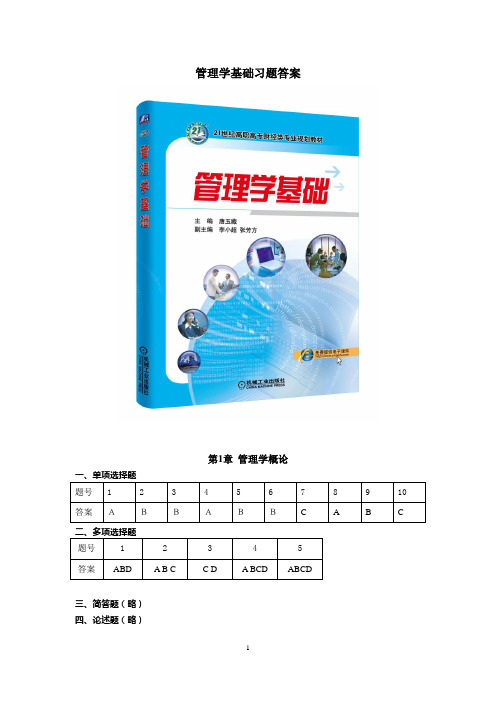
管理学基础习题答案第1章管理学概论一、单项选择题题号 1 2 3 4 5 6 7 8 9 10 答案ABBABB C A B C 二、多项选择题题号 1 2 3 4 5答案ABD A B C C D A BCD ABCD三、简答题(略)四、论述题(略)五、案例分析答案提示管理是科学,也是艺术。
公司的成败在于员工的积极性能否发挥,员工积极性的发挥在于领导艺术。
麦考密克在本应裁员减薪时,却减时提薪,乃惊人之举,属高超的领导艺术。
员工对领导的认可是领导权力有效行使的一个重要条件,领导和员工同舟共济的高昂士气是公司取之不尽的力量源泉。
困难和解决困难的办法是同时存在的,而且办法总比困难多,领导艺术是挖掘“办法”的技能。
第2章管理理论一、单项选择题1-5 A A C B C 6-10 A D D A C二、多项选择题1-5 AB ABC ABCD ABCD三、简答题1.(1)进行时间-动作研究。
制定出标准的操作方法和时间定额,以此来要求个人按科学标准来完成他们的工作。
(2)实行有差别的计件工资制,即按照个人完成定额的多少而采取不同的工资率。
(3)明确划分管理职能和作业职能,使管理工作独立出来,成为企业的一项职能。
(4)科学地挑选工人,并给予培训和指导,使他们能够按照标准化的程序去工作。
2.(1)法约尔第一个提出了“管理职能”的概念(2)“14条管理原则”(3)强调组织是一切管理活动的基础3.主要思想:(1)人是“社会人”而不是“经济人”。
把职工当做不同的个体来看待,当做社会人来对待,而不应将其视做无差别的机器或机器的一部分,不能单纯从技术和物质条件着眼,而必须首先从社会心理方面考虑合理的组织与管理。
(2)企业中存在着非正式组织(3)新的领导能力在于提高工人的满意度贡献:梅奥的人际关系理论为管理思想的发展开辟了新的领域,也为管理方法的变革指明了方向,并引起了管理上的一系列改革。
他注意研究人的需要与激励,强调非正式组织在管理中的重要作用。
管理学复习题(答案)
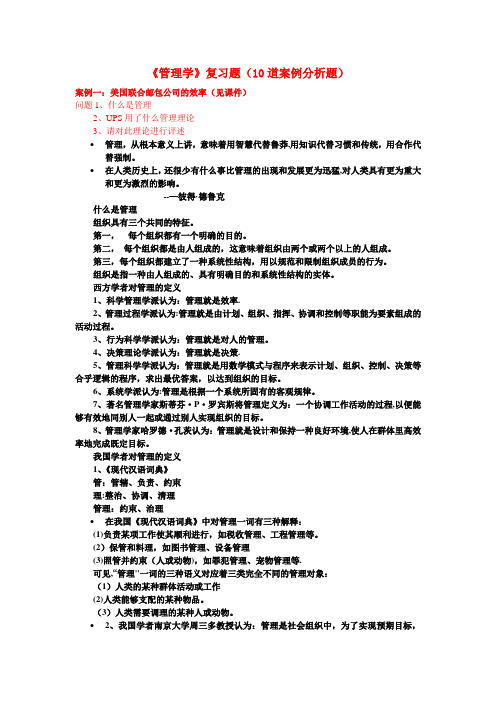
《管理学》复习题(10道案例分析题)案例一:美国联合邮包公司的效率(见课件)问题1、什么是管理2、UPS用了什么管理理论3、请对此理论进行评述•管理,从根本意义上讲,意味着用智慧代替鲁莽,用知识代替习惯和传统,用合作代替强制。
•在人类历史上,还很少有什么事比管理的出现和发展更为迅猛,对人类具有更为重大和更为激烈的影响。
--—彼得·德鲁克什么是管理组织具有三个共同的特征。
第一,每个组织都有一个明确的目的。
第二,每个组织都是由人组成的,这意味着组织由两个或两个以上的人组成。
第三,每个组织都建立了一种系统性结构,用以规范和限制组织成员的行为。
组织是指一种由人组成的、具有明确目的和系统性结构的实体。
西方学者对管理的定义1、科学管理学派认为:管理就是效率.2、管理过程学派认为:管理就是由计划、组织、指挥、协调和控制等职能为要素组成的活动过程。
3、行为科学学派认为:管理就是对人的管理。
4、决策理论学派认为:管理就是决策.5、管理科学学派认为:管理就是用数学模式与程序来表示计划、组织、控制、决策等合乎逻辑的程序,求出最优答案,以达到组织的目标。
6、系统学派认为:管理是根据一个系统所固有的客观规律。
7、著名管理学家斯蒂芬·P·罗宾斯将管理定义为:一个协调工作活动的过程,以便能够有效地同别人一起或通过别人实现组织的目标。
8、管理学家哈罗德·孔茨认为:管理就是设计和保持一种良好环境,使人在群体里高效率地完成既定目标。
我国学者对管理的定义1、《现代汉语词典》管:管辖、负责、约束理:整治、协调、清理管理:约束、治理•在我国《现代汉语词典》中对管理一词有三种解释:(1)负责某项工作使其顺利进行,如税收管理、工程管理等。
(2)保管和料理,如图书管理、设备管理(3)照管并约束(人或动物),如罪犯管理、宠物管理等.可见,“管理"一词的三种语义对应着三类完全不同的管理对象:(1)人类的某种群体活动或工作(2)人类能够支配的某种物品。
管理学第十版C2习题与答案

Chapter 2 Management Yesterday and TodayTRUE/FALSE QUESTIONSHISTORICAL BACKGROUND OF MANAGEMENT1.According to Adam Smith, division of labor was an important concept.(True)job specification.2.The division of labor is also referred to by the term(Ture)SCIENTIFIC MANAGEMENT3.Principles of Scientific Management was written by Frederick Winslow Taylor.(True)4.“Employee motivation” is the phrase most associated with scientific management.(False)5.Based on his scientific management principles, Taylor suggested the incentive pay principle.(True P27)6.Gilbreth is best known for “the one best way.”(False,p27)7.Henri Fayol was among the first researchers to use motion pictures to study hand-and-bodymotions.(False)GENERAL ADMINISTRATIVE THEORY8.Henri Fayol identified five functions of managers: p lanning, organizing, c ommanding,coordinating, and controlling.(True)9.The 14 principles of management are associated with Fayol.(True)and10.An organization that has a division of labor, a clearly defined hierarchy, detailed rules,impersonal relationships would be described as a bureaucracy.(True)11.Hugo Munsterberg created the field of social psychology.(True p. 33)12.Chester Bernard was the first to argue that organizations are open systems.(True; p. 33)13.Follett is the scientist who is most closely associated with the Hawthorne Studies.(False; p. 33)CURRENT TRENDS AND ISSUES14.According to the textbook, total quality management is a philosophy of management drivenby continual improvement and responding to customer needs and expectations.(True)MULTIPLE-CHOICE QUESTIONSmost completely answers the question.For each of the following choose the answer thatHISTORICAL BACKGROUND OF MANAGEMENT15.In Wealth of Nations, Adam Smith described t he breakdown of jobs into narrow andrepetitive tasks and called this ______________.a.assembly linesb.work denominationc.division of labord.greatest common factor of work(c)SCIENTIFIC MANAGEMENT16.Frederick Taylor performed most of his work in _______________.a.grape vineyards in Californiab.steel companies in Pennsylvaniac.auto assembly plants near Detroitd.cotton gins in Alabama(b)17.Before Taylor, which of t he following approaches was used to establish guidelines for anindividual’s work?a.scientific analysisb.rule-of-thumb methodc.process distillation( 提炼)d.mathematical modeling(b)18.Frederick Taylor advocated which of the following management principles?a.Work and responsibility should be divided almost equally between managers a ndworkers.b.Workers should perform all work, while management should maintain responsibility forthe work performed.c.Managers s hould perform more work that workers, because m anagers are generallymore skilled.d.Workers can be highly productive even if they are randomly selected for a job.(a p. 27 exhibit2-2)19.Frank and Lillian Gilbreth were the first researchers to utilize motion pictures to the study of_____________.a.reactions of workers in group settingsb.hand-and-body motionsc.workers reactions to pay increasesd.groups of workers in tense situations where they are assigning each other tasks(b)20.Which of the following phrases is most associated with scientific management?a.management relationsb.one best wayc.supply and demandd.quality control(b)21.The primary issue that motivated Taylor to create a more scientific approach to managementwas ______________.a.worker efficiencyb.worker effectivenessc.worker absenteeism and turnoverd.workplace safety(a)22.Probably the best-known example of Taylor’s scientific management was the______________ experiment.a.horseshoeb.pig ironc.blue collard.fish tank(b)GENERAL ADMINISTRATIVE THEORY23.General administrative theory focuses on ________________.a.the entire organizationb.managers and administratorsc.the measurement of organizational design relationshipsd.primarily the accounting function(a, p28)24.General administrative theorists devoted their efforts to _________________.a.developing mathematical models to improve managementb.improving the productivity and efficiency of workersc.making the overall organization more effectived.emphasizing the study of human behavior in organizations(c)25.Fayol was interested in studying ___________, whereas Taylor was interested in studying________.a.senior managers; effective managersb.all managers; first-line managersc.bureaucratic structures; chains of commandd.administrative theory; macroeconomics(b, p28)26.Bureaucracy is defined as a form of organization characterized by __________________.a.division of laborb.clearly defined hierarchyc.detailed rules and regulationsd.all of the above(d)QUANTITATIVE APPROACH27.The quantitative a pproach evolved from the development o f mathematical and statisticalsolutions to ______________.a.waiting line problems at fast-food restaurants in the 1960sitary problems in World War IIc.clogged telephone circuits during the 1930sd.production management problems in the 1950s(b, p30)28.The quantitative approach involves applications of _______________.a.statistics, information models, and computer simulationsb.psychology testing, focus groups, and mathematicsc.optimization models, interviews, and questionnairesd.surveys, strategic planning, and group problem solving(a)TOWARD UNDERSTANDING ORGANIZATIONAL BEHAVIOR29.According to the textbook, which of the following early advocates of organizationalbehavior was concerned about deplorable(糟糕的) working conditions?a.Robert Owensb.Hugo Munsterbergc.Mary Parker Follettd.Chester Barnard(a; p. 33)30.Which of the following early advocates o f organizational behavior created the field ofindustrial psychology, the scientific study of people at work?a.Robert Owensb.Hugo Munsterbergc.Mary Parker Follettd.Chester Barnard(b; p. 33)31.Which of the following early advocates of organizational behavior was the first to argue thatorganizations were open systems?a.Robert Owensb.Hugo Munsterbergc.Mary Parker Follettd.Chester Barnard(d, p. 33)32.Contemporary management practices that emphasize work groups as a means to increasingproductivity can be traced to which of the following authors?a.Robert Owenb.Mary Parker Follettc.Chester Barnardd.Hugo Munsterberg(b, p. 33)to the developing field of organizational33.Without question, the most important contributionbehavior came out of the ________________.a.Taylor studiesb.Porter studiesc.Parker studiesd.Hawthorne Studies(d, p. 34)34.The Hawthorne Studies were initially devised to study ______________.a.productivity levels of groups versus individualsb.the effect of noise on employee productivityc.the effect of illumination levels on employee productivityd.the effect of cooperative versus competitive organizational environments on productivity (c)35.What scientist is most closely associated with the Hawthorne Studies?a.Adamsb.Mayowlerd.Barnard(b)36.One outcome of the Hawthorne Studies could be described by which of the followingstatements?a.Social norms or group standards are the key determinants of individual work behavior.b.Money is more important than the group on individual productivity.c.Behavior and employee sentiments are inversely related.d.Security is relatively unimportant.(a)THE SYSTEMS APPROACH37.A system can best be defined as _________.a. a grouping of separate and independent partsb. a set of interrelated and interdependent partsc.an ordering of distinct and unrelated partsd. a set of connected but nonfunctional parts(b)38.Each of the following terms could be used to characterize systems except ________.a.unifiedb.fragmentedc.wholed.set(b)39.Which of the following is considered a systems input?a.management activitiesb.financial resultsc.operations methodsd.raw materials(d)40.Open organizations are those that _________.a.interact with their environmentsb.consist of interdependent partsc.are influenced by their environments, but do not interact with themd.operate independently of their environments(a)THE CONTINGENCY APPROACH41.A manager who believes that no one set of principles applies equally to all workenvironments is most likely advocating which management approach?a.contingencyb.workplace diversityanizational behaviord.knowledge management(a)42.Each of the following represents a popular contingency variable except ________.anization sizeb.individual differencesc.environmental uncertaintyd.ideal bureaucratic structure(d, p. 37)SCENARIOS AND QUESTIONSmost completely answers the question.For each of the following choose the answer thatManagement Intern(实习生) (Scenario)As an intern, Jeanna i s perplexed(使困惑)as she hears d ifferent m anagers discuss t heir views on particular problems. She has been assigned t o several departments d uring her internship.43.In trying to increase p roductivity, one manager utilizes a nalysis o f basic work tasks todetermine t he “one best way” f or different jobs to be done. It is most likely that thismanager has studied the work of _______________.a.Frederick Taylorb.Edward Demingc.Max Weberd.Henri Fayol(a)organization that stressed44.As she talked to another manager, Jeanna learned a view of thestrict division of labor, formal rules and regulations, and impersonal application o f thoserules and regulations. This manager was a student of _________________.a.the Industrial Revolutionb.quantitative methodsc.objectivismd.bureaucracy(d)TOWARD UNDERSTANDING ORGANIZATIONAL BEHAVIORThe Hawthorne Studies (Scenario)Paul was assigned a research project in the field of organizational behavior. He decided to write his report on the Hawthorne Studies. After writing his report, Paul gave an oral presentation to his management class.Studies p roject began as a test to determine the most45.Paul explained that the Hawthorneproductive _________________.a.reward structure for employeesb.level of lighting in the workplacec.number of breaks during a shiftd.number of days away from work per month(b)46.In describing t he research p roject, Paul informed h is classmates that the project studied_________________.a.employee behaviors and sentimentsb.group influences on individual behaviorc.how group standards affect individual behaviord.all of the above(d)47.Paul’s classmates w ere most likely surprised to learn about which of the followingconclusions of the study?a.Low light levels are associated with low worker productivity.b.Increases in lighting intensity cause group productivity to decrease.c.Increases in lighting intensity are directly related to increases in productivity.d.Lighting intensity is not directly related to group productivity.(d)48.Paul explained that the most important thing about these studies is that they________________.a.helped employees understand their own behavior, beginning the employeeempowerment movementb.stimulated interest in human behavior in organizationsc.concluded that employees were no different from machinesd.showed that managers had to be right in all their decisions(b)。
- 1、下载文档前请自行甄别文档内容的完整性,平台不提供额外的编辑、内容补充、找答案等附加服务。
- 2、"仅部分预览"的文档,不可在线预览部分如存在完整性等问题,可反馈申请退款(可完整预览的文档不适用该条件!)。
- 3、如文档侵犯您的权益,请联系客服反馈,我们会尽快为您处理(人工客服工作时间:9:00-18:30)。
1.Management affects employee morale but not a company’s financialperformance.(False)2.In order to be considered a manager, an individual must coordinate thework of others.(True)3.Effectiveness refers to the relationship between inputs and outputs. (False)4.Effectiveness is concerned with the means of getting things done, whileefficiency is concerned with the attainment of organizational goals. (False; p. 7)5.Efficiency is often referred to as “doing things right.”(True)6.The four contemporary functions of management are planning, organizing,leading, and controlling.(True)7.The roles of figurehead, leader, and liaison are all interpersonalroles.(True; p. 9)8.Determining who reports to whom is part of the controlling functionof management.(False; Organizing,9.Directing and motivating are part of the controlling function ofmanagement.(False;p. 8)10.Katz found that managers needed three essential skills: technical,human, and informational.(False; p. 11)11.Technical skills become less important as a manager moves into higherlevels of management.(True)12.A distinct purpose is important in defining an organization. (True)1.Someone who works with and through other people by coordinating theirwork activities in order to accomplish organizational goals is ___________.a.an assembly line workerb. a laborerc. a managerd. a salesperson(c)2.Which of the following types of managers is responsible for makingorganization-wide decisions and establishing the plans and goals that affect the entire organizationa.first-line managersb.top managersc.production managersd.research managers(b)3.The lowest level of management is ______________.a. a non-managerial employeeb. a department of research managerc. a vice presidentd. a first-line manager(d)4.The distinction between a managerial position and a nonmanagerialposition is _______________.a.planning the work of othersb.coordinating the work of othersc.controlling the work of othersanizing the work of others(b, Page 5)5.Wasting resources is considered to be an example of managerial_____________.a.efficiencyb.effectivenessc.inefficiencyd.ineffectiveness(c)6.Efficiency refers to _____________.a.the relationship between inputs and outputsthe additive relationship(加性关系) between costs and benefitsb.the exponential(指数关系) nature of costs and outputsc.increasing outputs regardless of cost(a; p. 7)7.An automobile manufacturer that increased the total number of carsproduced at the same cost, but with many defects, would be _____________.a.efficient and effectiveb.increasing efficiencyc.increasing effectivenessd.concerned with inputs(b; difficult)8.Today, the basic management functions are considered to be______________.a.planning, coordinating, staffing, and directingb.planning, organizing, leading, and directingmanding, organizing, leading, and staffingd.planning, organizing, leading, and controlling(d)9.Which of the following management functions from the mid-1950s is nolonger included in the basic functions of managementmandingb.staffingc.leadingd.controlling(b; p. 8)10.A manager resolving conflict among organizational members isperforming what functiona.controllingmandingc.directingd.leading(d; moderate; p. 8)11.The process of monitoring, comparing, and correcting is called_____________.a.controllingb.coordinatingc.leadinganizing(a)12.Acc ording to Mintzberg’s management roles, the _____________ rolesare those that involve people and other duties that are ceremonial and symbolic in nature.rmationalb.interpersonalc.technicald.decisional (b; p. 9)13.A human resource manager attending a local Society for Human ResourceManagement meeting would be functioning in which rolermationalb.leaderc.liaisond.disseminator(c; moderate; p. 9)14.A finance manager who reads the Wall Street Journal on a regular basiswould be performing which rolea.figureheadb.monitorc.disseminatord.interpersonal(b)15.The ability to work well with other people, both individually and ina group, requires ________________.a.technical skillsb.assessment skillsc.planning skillsd.human skills(d)16.One of the common characteristics of all organizations is_____________, which clarifies members’ work relationships.a.its peopleb.its goalsc.its deliberate structured.its purpose(c)17.A deliberate arrangement of people to accomplish some specific purposeis _____________.a. a structure.b. a process.c.an organization.d.an assembly operation(c)18.Universality of management means that _____________a.all managers in all organizations perform the four managementfunctionsb.all managers in all organizations can perform their job the samewayc.all organizations can hire any manager to perform the managementjobsd.any manager can work in any organization and perform any managementjob(a,P15)19.A primary responsibility of managers is creating a work environmentthat _______________.a.is safe and well litb.is clean and organizedc.allows employees to do their work to the best of their abilityd.provides excellent customer service(c)。
